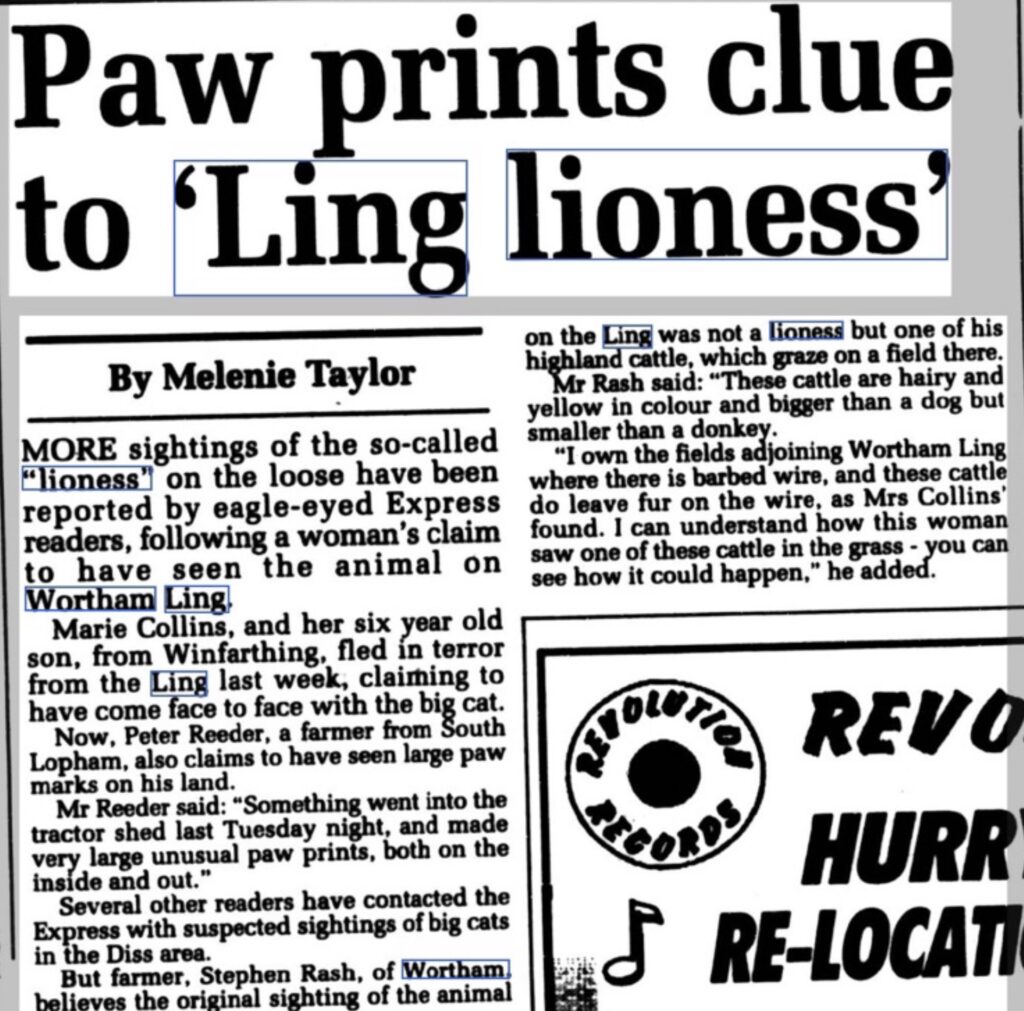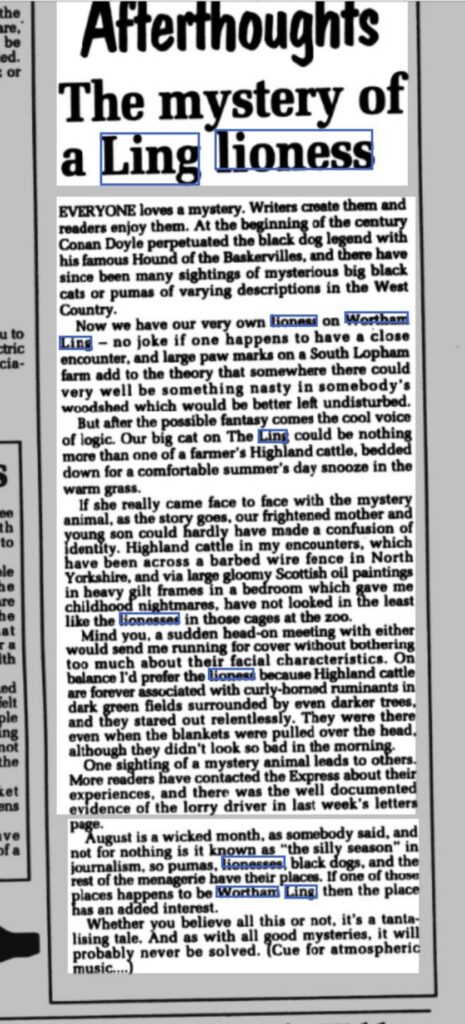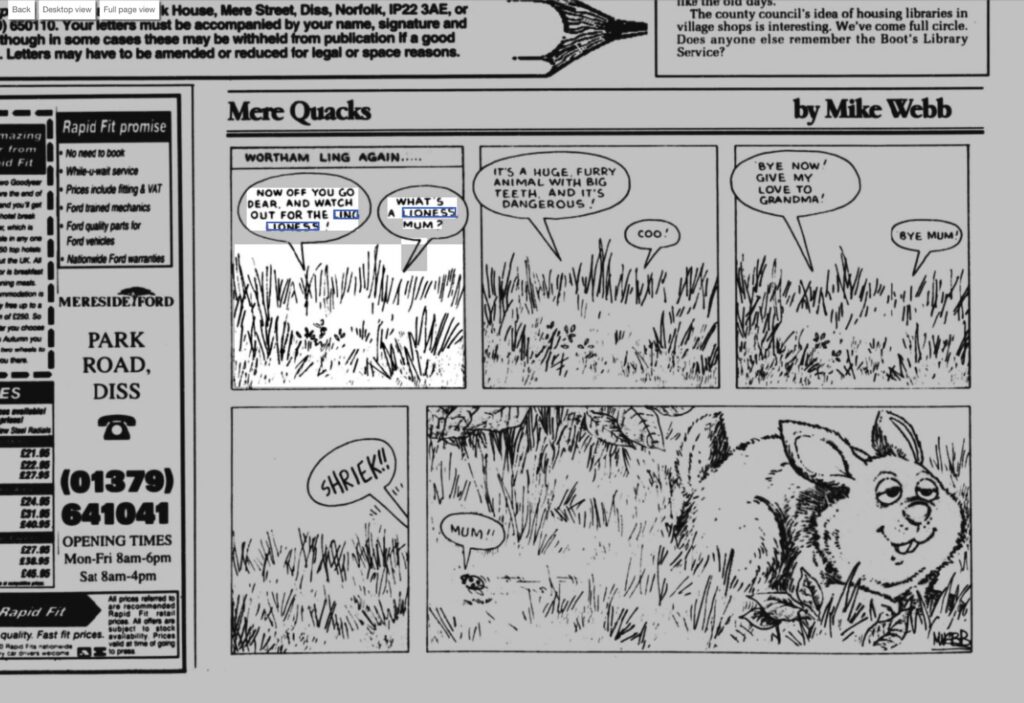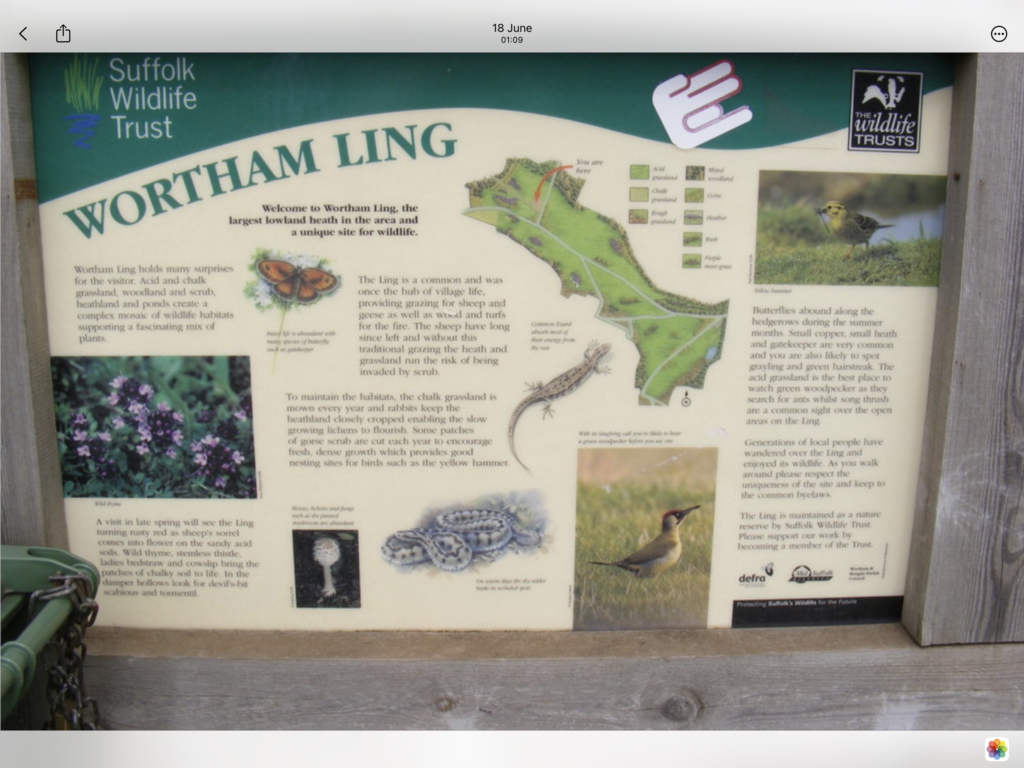
Suffolk Tales, original linocut by artist Gill Thornton, gill-thornton.co.uk inspired by reported sightings of big cats roaming the Suffolk countryside. Used with her kind permission.

Back in June 2025 I was contacted by Gill Thornton, who was preparing to submit artwork to the Black Shuck Festival for that year. She had chosen as a theme a “black panther” seen at Wortham Ling nature reserve, on the Norfolk-Suffolk border, she remembered seeing a blurry photo in the Diss Express local newspaper of a black panther photographed around the nature reserve around the late 1980s. She remembered the animal being dubbed “the Lioness of Ling” at the time.
Thanks to the Edinburgh Fortean Society, I was able to track down some newspaper articles online from the Diss Express. But these were from a later date – August 1996, and they described not a “black panther” but a big cat of a “golden sandy colour”, more like a puma than a melanistic leopard.
Under the headline “Lioness of Ling?”, Melanie Taylor’s Diss Express article from 16 August 1996 described how Marie Collins of Winfarthing and her six-year-old son Robert were walking their dog on the nature reserve (new paths had been opened on the reserve the previous year) when they saw “a large animal… a lioness.”
The Express went on note that “the sighting of a large cat follows numerous other reporting sightings of a puma in the area during the last few years.” Mrs Collins had dubbed the animal she saw a “lioness”, and the Lioness of Ling name seems to have stuck because it’s alliterative and therefore cool, but “lionesses” seen in the wild in Britain are most likely pumas.
Lions are animals of open savannah not the undergrowth, they’re not well adapted to living in the wild in the UK. Lions that do escape from captivity are usually recaptured or shot with a few days, like the escaped lion shot in Cromer, Norfolk in January 1984. The “Darsham Lion” seen dozing by the verge of what was then the Little Chef (now the Two Magpies) in the village of the same name in 2003 was most likely a puma. The “Debenham Lion” seen several times in the 1980s was most likely a puma or possibly a misidentified Maine coon cat. The “Debenham Lion” name probably attached itself to it because that was the name of the local pub (since closed). Both the Debenham Lion and the Darsham Lion are covered in Mystery Animals of Suffolk.
Mrs Collins said of her encounter with the Lioness of Ling “I thought I had seen a lioness. My son screamed and we ran for our lives to the car… I could see its whole body, it was a golden sandy colour, and was lying in a field. It turned around and looked at me, and that is when we ran… It was much too big to be a dog and too small to be a donkey.” She also described finding “clumps of fur on some wire nearby.”
Steve Hammond of the Upper Waveney Valley Project, that has a role in managing the Wortham Ling nature reserve, believed it was “quite plausible that large cats were living wild in the area” among “a great deal of shrubbery and brambles for the animals to hide in and plenty of food to eat.” He probably meant large feral or domestic cats, though. PC Graham Pettitt of Halesworth Police confirmed that they’d been contacted but could find no trace of the animal. There was the usual confirmation that all big cats kept in local zoos were accounted for.

Diss Express journalist Melanie Taylor followed up with another article on 23 August 1996, “Paw prints clue to ‘Ling lioness’”. Peter Reader, a farmer from nearby South Lopham, claimed to have seen “large paw marks on his land” subsequent to the Collins’s sighting. Something had gone into the tractor shed and made “very large unusual paw prints, both inside and out.” Other readers had also since contacted the Express with “suspected sightings of big cats in the Diss area,” although no more detail was given.
But in response to Mrs Collins’s testimony about finding on nearby barbed wire the fur of the animal of a “golden sandy colour”, local Wortham-based farmer Stephen Rash said his field adjoining Wortham Ling nature reserve has highland cattle in it, and that would account for the fur left on the wire. He speculated that the Collins’s could briefly have seen one of his highland cattle and mistaken it for a lioness. (The bit about misidentifying the fur on some barbed wire seems to me much more likely than mistaking a horned highland cow for a puma.)

The “Afterthoughts” column of the Diss Express of 30th August 1996, “Kay Hunter’s Views on Country Life,” had the title “The mystery of a Ling lioness”. In a rather lame column that didn’t really come to any conclusions, Hunter agreed that it would be hard to misidentify a Highland cow, but also expressed the opinion that “August is a wicked month” and made hints about the “silly season.” She did refer, however, to more readers recently contacting the Express about their experiences” and “the well documented evidence of the lorry driver in last week’s letters page.”
The Ling lioness was apparently still enough in people’s minds to be referenced in an equally lame Diss Express Mere Quacks cartoon strip by Mike Webb on 27 September 1996.

The year 1996, the year of the sightings in Ling, saw the beginning of a wave of big cat sightings across Ipswich and environs and South Suffolk, although most witnesses reported a black big cat, which was given the nickname “Claws” by the Ipswich-based Evening Star newspaper. There were a few reports of puma-like cats seen, while an anonymous reader contacted the East Anglian Daily Times in 1997 to say that he’d recently released somewhere a male puma named Khyber. (It’s all in Mystery Animals of Suffolk.)
Gill Thornton has a vague memory, though, of a blurry photo of a black big cat appearing in the Diss Express in the late 1980s, she can’t pinpoint the year. Research into mystery animals has shown, though, that our recollections of newspaper articles seen decades ago can be wrong. Diss Express did have very good coverage of big cat sightings up until at least the mid-2010s.
This phenomenon is known in cryptozoology (the study of animals not yet formally described to science) as “the Thunderbird photo”,after a missing photo said to show American soldiers in uniforms from around the Civil War era, posing with their firearms around a pterodactyl-like animal they’ve shot down. The photo was said to have a barn in the background, and so on. People insist they’d seen the Thunderbird photo in a newspaper or magazine, but it cannot be found. Various attempts have been made to fake it, these are usually quickly proven to be hoaxes, mostly because the re-enactors in Civil War uniforms are middle-aged and a bit overweight, unlike the very young and half-starved authentic Civil War era soldiers.
It is entirely possible that Gill Thornton did see a blurry photo of a black big cat in the Diss Express of the late 1980s as well, and that it had been forgotten about by 1996. (Journalists didn’t stay long in local news in those days either.) Or maybe her recollection is correct but the date was later.
I heard a story about a man who “kept lions” in a village near Diss in the late 1960s or early 1970s, and that some government agency seized these, and that it was in the Diss Express at the time, but as yet I’ve not been able to track this article down.
I also heard via the Edinburgh Fortean Society that the Ling lioness was a persistent rumour among school students locally from the late 1980s.

Suffolk Wildlife Trust’s interpretation board on Wortham Ling nature reserve in 2025.